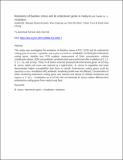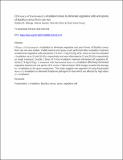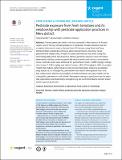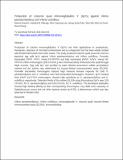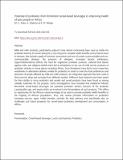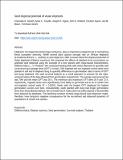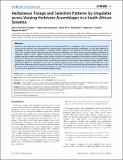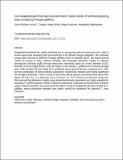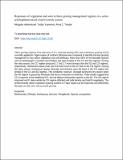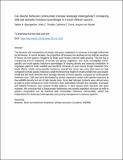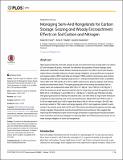Research Articles [LISBE]: Recent submissions
Now showing items 641-660 of 886
-
Resistance of Bacillus cereus and its enterotoxin genes in ready-to-eat foods to γ-irradiation
(Springer Nature Switzerland AG., 2012-04-30)This study was investigated the resistance of Bacillus cereus ATCC 13752 and its enterotoxin coding genes in cereals, vegetables, and tryptic soy broth to γ-irradiation. Screening for enterotoxin coding genes, viability ... -
Production of mouse anti-quail IgY and subsequent labeling with horseradish peroxidase using cyanuric chloride.
(J. Microbiol. Biotechnol, 2013-04-01)Polyclonal antibodies labeled with a tracer have been commonly used as secondary antibodies in immunochemical assays to quantify the concentration of antibody-antigen complexes. The majority of these antibodies conjugated ... -
Efficiency of fractionated γ-irradiation doses to eliminate vegetative cells and spores of Bacillus cereus from raw rice
(2013-04-30)Efficacy of fractionated γ-irradiation to eliminate vegetative and spore forms of Bacillus cereus from raw rice was studied. Viable bacteria and spores count performed after irradiation treatment revealed that vegetative ... -
Pesticide exposure from fresh tomatoes and its relationship with pesticide application practices in Meru district
(Cogent OA, 2016-06-16)Tomato pesticides health risk was assessed in Meru district of Arusha region, one of the key tomato producers in Tanzania. Tomato samples and consumption information were collected from 50 farmers using Food and Drug ... -
Production of Coturnix quail immunoglobulins Y (IgYs) against Vibrio parahaemolyticus and Vibrio vulnificus
(Springer Nature Switzerland AG., 2011-12-31)Production of chicken immunoglobulins Y (IgYs) and their applications in prophylactic, therapeutic, detection of microbial contaminants and as a diagnostic tool has been widely studied with limited information from other ... -
Prevalence and speciation of brucellosis in febrile patients from a pastoralist community of Tanzania.
(Springer Nature Limited, 2020-04-27)Brucellosis is an endemic zoonosis in sub-Saharan Africa. Pastoralists are at high risk of infection but data on brucellosis from these communities are scarce. The study objectives were to: estimate the prevalence of human ... -
Molecular identification of Salmonella Typhimurium from village chickens based on invA and spvC genes
(Veterinary World, 2020-04-23)Aim: This study aimed to identify Salmonella enterica serovars by polymerase chain reaction (PCR) based on virulence genes invasion A (inv A) and Salmonella plasmid virulence C (spvC). Materials and Methods: DNA extraction ... -
Potential of probiotics from fermented cereal-based beverages in improving health of poor people in Africa
(Springer Nature Switzerland AG., 2020-04-17)Milk and milk products; particularly yoghurts have almost exclusively been used as media for probiotic delivery to human being for a very long time. Despite health benefits such products have to humans; that include supply ... -
Seed dispersal potential of Asian elephants
(Elsevier, 2016-11)Elephants, the largest terrestrial mega-herbivores, play an important ecological role in maintaining forest ecosystem diversity. While several plant species strongly rely on African elephants (Loxodonta africana; L. cyclotis) ... -
Herbaceous Forage and Selection Patterns by Ungulates across Varying Herbivore Assemblages in a South African Savanna
(PLOS ONE, 2013-12-16)Herbivores generally have strong structural and compositional effects on vegetation, which in turn determines the plant forage species available. We investigated how selected large mammalian herbivore assemblages use and ... -
Assessing the Sustainability of Different Small-Scale Livestock Production Systems in the Afar Region, Ethiopia
(MDPI, 2013-12-02)Livestock production is a key income source in eastern Africa, and 80% of the total agricultural land is used for livestock herding. Hence, ecological and socio-economically sustainable rangeland management is crucial. Our ... -
Can rangelands gain from bush encroachment? Carbon stocks of communal grazing lands invaded by Prosopis juliflora
(Elsevier Ltd., 2017-06)Rangeland ecosystems are rapidly declining due to overgrazing and bush encroachment. Little is known about how important bush encroachment is for climate change mitigation. We estimated woody plant biomass at different ... -
Biodiversity and ecosystem services−A case study for the assessment of multiple species and functional diversity levels in a cultural landscape
(Elsevier B.V., 2017-04)The expansion of large-scale plantations has a major impact on landscapes in the Tropics and Subtropics. Crops like soy bean, oil palm and rubber have led to drastic changes in land cover over the past decades, thereby ... -
Rangeland forage availability and management in times of drought – A case study of pastoralists in Afar, Ethiopia
(Elsevier, 2017-04)Many Eastern African rangelands comprise marginal land, where climatic conditions are poor, access rights are increasingly limited, and land degradation is progressing. We conducted participatory land use mapping and ... -
Responses of vegetation and soils to three grazing management regimes in a semi‐arid highland mixed crop‐livestock system
(John Wiley & Sons, Inc., 2014-10-14)Three grazing regimes [Cut‐and‐carry (CC), seasonal grazing (SG) and continuous grazing (CG)] currently applied in Tigrai region of northern Ethiopia were compared to identify the best grazing management in key native ... -
Can diverse herbivore communities increase landscape heterogeneity? Comparing wild and domestic herbivore assemblages in a South African savanna
(Elsevier, 2015-02)The structure and composition of woody and grassy vegetation in savannas is strongly influenced by herbivores. In recent decades, the proportion of browsers has declined across African savannas in favour of more grazers, ... -
Managing Semi-Arid Rangelands for Carbon Storage: Grazing and Woody Encroachment Effects on Soil Carbon and Nitrogen.
(PLOS ONE, 2015-10-13)High grazing intensity and wide-spread woody encroachment may strongly alter soil carbon (C) and nitrogen (N) pools. However, the direction and quantity of these changes have rarely been quantified in East African savanna ... -
Is wild meat luxury? Quantifying wild meat demand and availability in Hue, Vietnam
(Elsevier B.V., 2016-02)Increasing urban wild meat consumption in Vietnam poses a major threat to faunal biodiversity. However, little is known about the numbers, demand, social status, and frequency of wildlife meat consumers in Thua Thien Hue ... -
Mammalian wildlife diversity in rubber and oil palm plantations.
(CABI, 2016-07-27)In the face of globally diminishing natural habitats in biodiversity-rich regions, agricultural landscapes around protected areas have increasingly gained importance as extended habitat for wildlife species. Rubber (Hevea ... -
Bionomics of the African Apefly (Spalgis lemolea) as A Potential Natural Enemy of the Papaya Mealybug (Paracoccus marginatus) in Tanzania
(MDPI, 2020-04-14)The African apefly (Spalgis lemolea Druce) is a potential natural enemy of the papaya mealybug (Paracoccus marginatus Williams and Granara de Willink). We studied the life history of apeflies in the laboratory at a temperature ...

